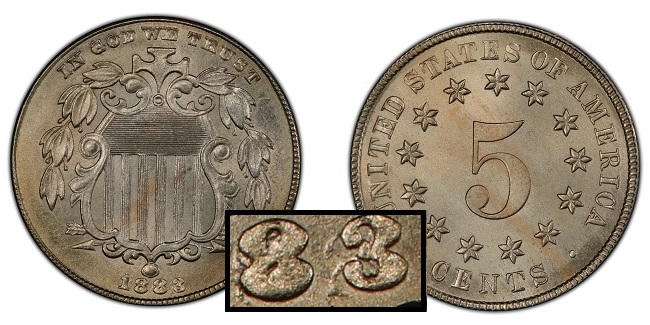1883 Shield Nickel, 3/2
Mint Director James Pollock proposed in 1865 that a five cent face value coin composed of a copper-nickel alloy be produced. The silver half dime was still being minted, but like most silver coins in the Civil War era, had difficulty remaining in circulation because of fearful hoarding.(1)
Fractional paper currency worth five cents circulated readily, but was a poor substitute for hard coinage, Pollock concluded.
On May 16, 1866, a five cent coin composed of 75% copper and 25% nickel was officially authorized.
Designer James B. Longacre chose a shield for the obverse side, patterned after the shield design of the Two Cent coin released in 1864. Thus, the name "Shield nickel" was applied to this coin type. The reverse contained a large numeral 5, encircled by 13 stars, with rays interspersed between the stars.
The first Shield nickels rolled off the presses in 1866. It didn't take long to realize the rays caused problems with metal flow during striking, resulting in many coins of poor sharpness. Early in 1867, the rays were removed from the design.
In 1882, the Philadelphia Mint churned out nearly 11.5 million Shield nickels, one of the highest mintages of the entire series. Anticipating a large production volume, many 1882 dies were prepared, but some were unused by year’s end. Instead of trashing them, the Mint’s craftsmen overdated the “2” on a few dies with a “3” to strike 1883 nickels.(2)
Because the overdating process was done manually, every overdated die is unique – that is, there are identifiable differences between the placement of the “2” relative to the “3”. For some dies, the underneath “2” barely shows, while for others, the “2” displays clearly and is visible even to the naked eye.
There are at least five 1883/2 Shield nickel die varieties that command premiums over ordinary 1883 nickels. The most important of these is the FS-301. For this die variety, the overdate is dramatic, with the “2” to the left of the “3” being rather obvious.
The FS-301 die variety is the most desirable and popular 1883/2 Shield nickel with collectors. It is the FS-301 whose values are reflected in the Redbook and other coin price guide listings. The trend charts on this page are for the FS-301.
Speaking of trends, the 1883/2 Shield nickel did incredibly well from 1990 to around 2010. Since then, we’ve seen mostly flatlining. If past is prologue, at some point we can expect a renewed surge of price hikes for this fascinating (and still affordable!) nickel.
| Estimated survivors in all grades: 300 ?
The survivor estimate from PCGS represents an average of one or more experts' opinions as to how many examples survive of a particular coin in all grades. Survival estimates include coins that are raw, certified by PCGS, and certified by other grading services. Learn more at PCGS. |
| PCGS Rarity Scale: 6.4 ?
The 'PCGS CoinFacts Rarity Scale' assesses the relative rarity of all U.S. coins, based on estimated surviving examples. The scale runs from 1.0 to 10.0. The higher the number, the rarer the coin.
Learn more at PCGS. |
| Click HERE to check for availability on eBay** |
Preview of eBay selection:
 |
|
| Trendline Avg = 25.06 | BETTER |
Historic Value Trend Charts:
| Last updated 2-5-25 | Return to Key Date Coin List | |
| Compare to Common Date Coin of Same Type | ||
|
|
||
| Download Charts to Your Computer | ||
Sources
1. Bowers, Q. David. The History of United States Coinage. Los Angeles, CA: Bowers and Ruddy Galleries, Inc., 1979.
2. PCGS. Shield Nickel.
**Many very fine coin dealers sell on eBay. At any point in time, there may be over one million search results for United States coins. This includes quite a few of the recommendations on our Key Date Coin List.
If you’re thinking about purchasing a rare coin, eBay is certainly worth a look. For your convenience, the links from this site to eBay are coded to bring up only coins certified by PCGS and NGC.
As is always, always the case, never buy a valuable coin from a seller whose trustworthiness cannot be verified. Learn more about this at our chapter Best Places to Buy Coins, which also has a section on doing business on eBay.
In the interest of full disclosure, Rare Coins 101 receives a small commission anytime someone connects to eBay from this site and purchases something.
Coin images by PCGS.


